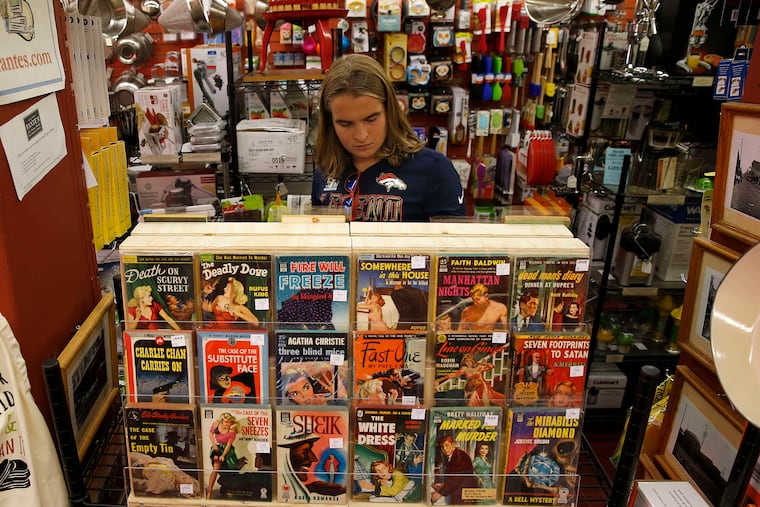'Stock Exchange' turns Italian Market into art
Patrons at the Italian Market may be noticing some unexpected and incongruous products in some of their favorite stores.

Patrons at the Italian Market may be noticing some unexpected and incongruous products in some of their favorite stores.
Eight stores along the market corridor are participants and shareholders in a new art project, Ninth Street Stock Exchange, created by artist Jon Rubin in collaboration with curator Theresa Rose. Flowers, kitchenware, vintage books and records, professional music equipment, clothing, jewelry, and handmade art and crafts will circulate among the stores. Each proprietor has selected a signature product that will rotate weekly.
At Molly's Books & Records, mannequins wear sparkly embellished hats on exchange from J&J Discount. At Fante's Kitchen Shop, a vibrant selection of pulp fiction paperbacks from Molly's sits next to Le Creuset pots. Titles like All Men Are Liars and Murder My Love are playfully framed by gleaming kitchen knives. Every Wednesday, the products rotate to another store, so these books will keep company with strobe lights at Casanova Music Center and fetching outfits at Alejandra's Boutique.
The project is funded with a 2013 Knight Arts Challenge grant and supported by the City of Philadelphia's Mural Arts Program. The main inspiration, Rubin said, was the dynamics of the market itself. "I was interested in seeing what might happen when businesses in the market that are separated by cultural and socioeconomic differences were connected in a mutual exchange," he said. "Might this encourage stores and customers alike to encounter products and cultures that normally lie outside their usual interests? What new relationships might occur when each participant business becomes invested in a small way in the commercial welfare of the others?"
A Philly-area native now based in Pittsburgh, Rubin is known for cofounding Conflict Kitchen, a take-out restaurant on a central plaza in Pittsburgh serving foods from countries with which the United States is in conflict, such as Iran, North Korea, and Palestine. Rose, his South Philly collaborator, organized the Philly Stake micro-granting dinner series and served as public art project manager for the city's Office of Arts, Culture, and the Creative Economy.
As most shoppers and diners know, the Italian Market has become a much more global market in recent years. Washington Avenue, its traditional southern border, is something of a divider between the older, more established (and more likely to be Italian) vendors to the north and the newer, immigrant-run businesses to the south that cater to growing Hispanic and Asian communities.
The artists treat each store as an exhibition space, with attention to detail. (Example: Each exchange product is accompanied by a handwritten price tag that explains where it came from.) Working week to week with store owners to maximize the visual impact of each installation, the artists are carefully choreographing the dislocation you might feel when you encounter a culturally specific product out of its habitual setting.
Let's say we're used to seeing a Santa Muerte statue (a Mexican folk saint who looks like a prettier version of the Grim Reaper) sitting inside a shop we never go into. But what if we encounter Santa Muerte in the grocery store? "What's that doing there, next to the olive oil?" we might ask. It might provoke curiosity, even wonder, about our surroundings, letting us look at ordinary things with the same care we devote to art objects.
Near Federal Street toward the southern end of the market, Eva Hernandez, a native of Mexico City, opened Chocolate Arts & Crafts six months ago. Since joining the exchange, Hernandez has gotten to meet other shop managers face to face. Shareholders introduced themselves and their products, the better to learn about one another's businesses - and handle shoppers' questions. "I think it's a beautiful idea that lets us connect and learn from each other," said Hernandez. "We are very close but we don't know each other. We never talked to each other before."
"It takes so much time and energy to run a small business," said Molly Russakoff, a third-generation bookseller and longtime Ninth Street resident who opened her bookstore in 2001. "We can get to be very focused on our own businesses. Sometimes we don't make time to walk into places that are next door."
"For 30 years, I've been part of many projects with people who are so different, who sometimes are in great conflict with one another - yet the creative process always pushes through boundaries and divisions," said Jane Golden, executive director of the Mural Arts Program. "Jon's project asks, 'How do we do something that shines a light on our diversity and find commonality within that diversity?' That is something wonderful and very much needed in today's world."